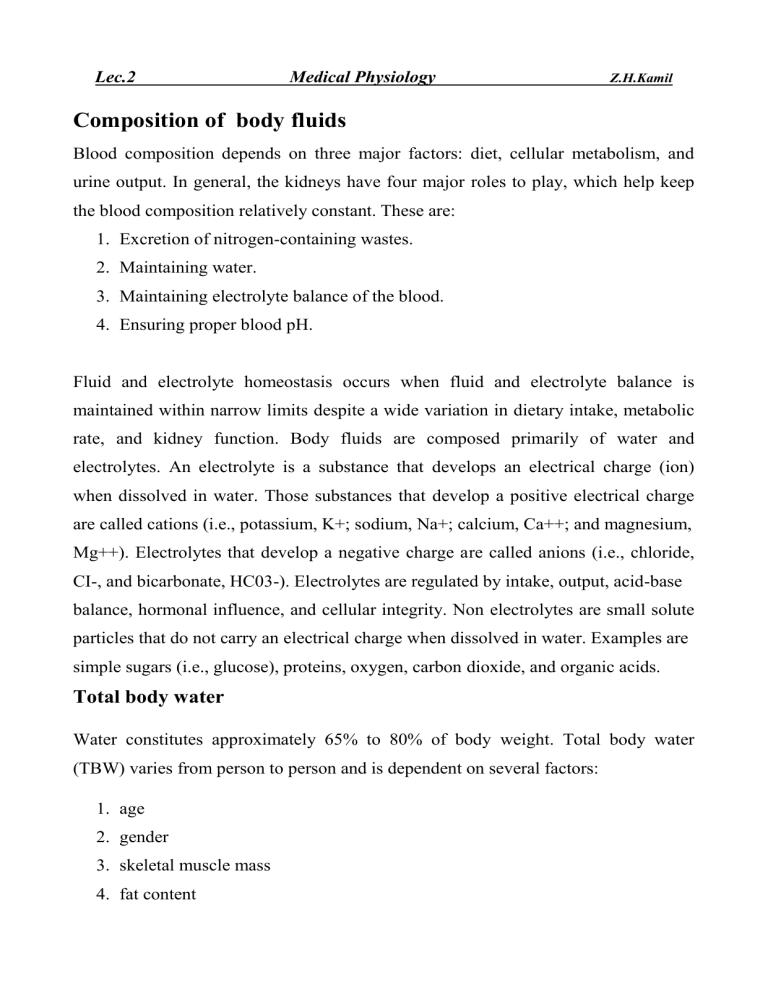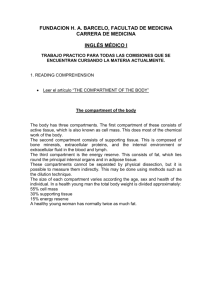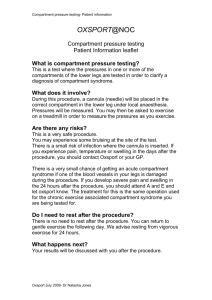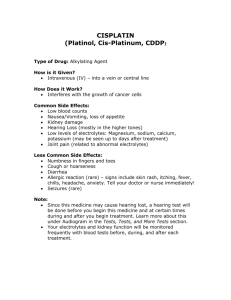Maintaining Acid-Base Balance of Blood

Lec.2 Medical Physiology Z.H.Kamil
Composition of body fluids
Blood composition depends on three major factors: diet, cellular metabolism, and urine output. In general, the kidneys have four major roles to play, which help keep the blood composition relatively constant. These are:
1.
Excretion of nitrogen-containing wastes.
2.
Maintaining water.
3.
Maintaining electrolyte balance of the blood.
4.
Ensuring proper blood pH.
Fluid and electrolyte homeostasis occurs when fluid and electrolyte balance is maintained within narrow limits despite a wide variation in dietary intake, metabolic rate, and kidney function. Body fluids are composed primarily of water and electrolytes. An electrolyte is a substance that develops an electrical charge (ion) when dissolved in water. Those substances that develop a positive electrical charge are called cations (i.e., potassium, K+; sodium, Na+; calcium, Ca++; and magnesium,
Mg++). Electrolytes that develop a negative charge are called anions (i.e., chloride,
CI-, and bicarbonate, HC03-). Electrolytes are regulated by intake, output, acid-base balance, hormonal influence, and cellular integrity. Non electrolytes are small solute particles that do not carry an electrical charge when dissolved in water. Examples are simple sugars (i.e., glucose), proteins, oxygen, carbon dioxide, and organic acids.
Total body water
Water constitutes approximately 65% to 80% of body weight. Total body water
(TBW) varies from person to person and is dependent on several factors:
1.
age
2.
gender
3.
skeletal muscle mass
4.
fat content
The water content of adipose tissue is approximately 10% as compared with a water content of 73% in lean body tissues. Thus the amount of fat in the body determines, to a major degree, the amount of water. As the infant and child mature, TBW, as a percentage of body weight, changes. During the first year of life, the total body fluid percentage decreases, with the most rapid change occurring in the first 6 months.
TBW accounts for 75% 80% of body weight in the newborn, 70% at 6 months, and
65% at 1 year of age. In children, the percentage of total weight as body water decreases steadily until the adult percentage (55% to 60%) is reached at about 8 years of age.
In healthy young adult, water probably is half or more of body weight—50 percent in females and about 60 percent in males. These differences reflect the fact that females have relatively less muscle and a larger amount of body fat ( fat contains the least water). Water is the universal body solvent within which all solutes (including the very important electrolytes) are Dissolved.
TBW is distributed in two separate compartments: the intracellular fluid (ICF) compartment and the extracellular fluid (ECF) compartment (Fig. 1).
Intracellular Compartment. ICF consists of all liquid within the cell membranes of the body and is the largest fluid compartment, accounting for 40% of the body weight. Much of the ICF compartment is found within muscle cells. The primary electrolytes of the ICF compartment are potassium and phosphate. The ICF compartment contains only small quantities of sodium and chloride ions and almost no calcium ions. The cells contain 4 times as much protein as the plasma.
Extracellular Compartment. The extracellular compartment is not a homogenous compartment. It is composed of interstitial fluid (ISF), plasma, and transcellular water (TSW). The lSF bathes all of the body cells and includes lymph fluid, the largest component of ECF compartment. ISF volume accounts for approximately
20% of TBW. Plasma is the liquid component of whole blood, contained within the vascular system. Although plasma accounts for only 8% of TBW, it is essential to the functioning of the cardiovascular system. TSW is composed of the fluids found in pleural, pericardial, synovial, peritoneal, and joint spaces. In addition, TSW includes the secretions of the salivary glands and pancreas and fluid in the respiratory and gastrointestinal tracts. The function of TSW is to either lubricate or cushion. TSW accounts for a small portion of TBW; however, it can increase during certain disease states.
The serum or plasma portion of the extracellular compartment contains the electrolytes found in the ECF compartment and a large amount of protein. The plasma proteins determine colloid osmotic (oncotic) pressure, with the most abundant
plasma protein being albumin. Albumin, because of its size, remains in the vascular space and exerts a differential osmotic pressure between the capillary lumen and the interstitial space. The consequence is maintenance of volume in the intravascular space. Oncotic pressure is also important in the kidney, influencing filtration and reabsorption of water and solutes. The ECF compartment contains large quantities of sodium and chloride ions; reasonably large quantities of bicarbonate ion; and small quantities of potassium, calcium, magnesium, phosphate, sulfate, and organic acid ions. The ECF compartment makes up just 20% of body weight in the adult.
Regulation of Water and Electrolyte Balance
A dynamic relationship exists between the extracellular and intracellular fluid compartments. This relationship maintains cellular homeostasis through the exchange of fluids and electrolytes. The compartments are kept separate by the structural and functional integrity of cell membranes. Both passive and active processes regulate the movement of water and solutes across the cell membrane. The selective permeability of the cell membrane and the specific active transport activity of the cell determine the characteristics of intracellular and extracellular fluid compartments. A profound alteration in anyone of the fluid compartments can disrupt cellular health and may result in a fatal systemic response.
Most water intake is a result of fluids and foods ingested in diet. However, a small amount (about 10 percent) is produced during cellular metabolism.
There are several routes for water to leave the body:
1.
Some water vaporizes out of the lungs.
2.
Some water is lost in perspiration.
3.
Some water leaves the body in the stool.
If large amounts of water are lost in other ways, the kidneys is putting out less urine to conserve body water. On the other hand, when water intake is excessive, the kidneys excrete generous amounts of urine.
Electrolytes such as sodium, potassium, and calcium ions, are also vitally important to overall body homeostasis, and water and electrolyte balance are tightly linked as the kidneys continuously process the blood. Very small changes in electrolyte balance, the solute concentrations in the various fluid compartments, cause water to move from one compartment to another. Not only does this alter blood volume and blood pressure, but it can also severely impair the activity of irritable cells like nerve and muscle cells. For example, a deficit of sodium ions (Na+) in the ECF results in water loss from the bloodstream into the tissue spaces (edema) and muscular weakness.
Most electrolytes enter the body in foods and mineral-rich water. Although very small amounts are lost in perspiration and in feces, the major factor regulating the electrolyte composition of body fluids is the kidneys.
Movement of Fluids and Electrolytes
For water and electrolytes to function effectively in the body, a regulatory process that controls fluid movement is required. The regulatory process is dependent on the concentration of the specific fluid or electrolyte (osmolality) and on the functioning capacity of the renal system. Fluids move constantly from one body compartment to another and then remain in specific compartments until an inequality in concentration of electrolytes develops. Then, movement once again occurs. Movement is through one of four transport mechanisms: osmosis, diffusion, filtration, and active transport.
Osmosis is the movement of water through a semipermeable membrane from an area of lower solute content to an area of higher solute activity (with lower activity of water molecules). Osmosis occurs only when the membrane is more permeable to
water than solutes. The force of the movement, or shift, of water depends on serum osmolality, which controls distribution and movement of water between compartments.
Normally, the amount of water that diffuses in and out of the cell is balanced, and the volumes within the extracellular and intracellular fluid compartments remain constant. Because water moves freely between the blood, ISF, and tissues, changes in the osmolality of one body compartment produce a shift in all other compartments.
Consequently, in most cases, the osmolality of the plasma is equal to the osmolality of other compartments.
Diffusion is the movement of a substance (electrolytes and non electrolytes) from an area of higher concentration to one of lower concentration through a solution or gas.
Diffusion ceases when equilibrium occurs.
Electrical potential differences and pressure differences across the pores of a semipermeable membrane also influence diffusion, although the most important factor determining the rate of diffusion is the concentration difference. The greater the concentration difference, the greater the rate of diffusion.
Molecules moving via simple diffusion must possess one of two capabilities: lipid solubility or a negative charge. The lipid-soluble molecules, such as oxygen, carbon dioxide, and alcohol, are able to diffuse readily through the lipid component of the cell membrane. Chloride is an example of a negatively charged particle able to pass easily through the membrane pores.
Filtration is the transfer of water and dissolved substances through a semipermeable membrane from a region of high pressure to a region of low pressure. The force causing filtration is hydrostatic pressure. An example of filtration is the passage of water and electrolytes from the arterial capillary bed to the ISF in response to blood pressure. The pumping action of the heart causes the hydrostatic pressure.
Movement against a concentration or electrochemical gradient is known as active transport, and energy, in the form of adenosine triphosphatase (ATPase), is required for the activity . The transport occurs somewhat like a "pump" in the membrane of the cell, driven by the energy generated by cellular respiration. Regulation and distribution of sodium and potassium within the interstitial and the intracellular fluid compartments are via the sodiumpotassium pump. Active transport is necessary to move sodium from the cells to the ECF compartment. The active process of pumping sodium out of the cells forces potassium into the cell.
Not only is energy required to move substances against a concentration gradient, but a carrier substance is required for the transport of sodium, potassium, chloride, sugars, and amino acids. Carrier substances are either a protein or a lipoprotein. The protein carriers function by providing an attachment site for the specific substance to be transported. The lipoprotein facilitates the solubility of the substance in the lipid portion of the cell membrane.
Reabsorption of water and electrolytes by the kidneys is regulated primarily by hormones :
1.
Highly sensitive cells in the hypothalamus called osmo-receptors react to the change in blood composition by becoming more active. The result is that nerve impulses are sent to the posterior pituitary which then releases antidiuretic hormone (ADH), this hormone prevents excessive water loss in the urine.
As more water is returned to the bloodstream, blood volume and blood pressure increase to normal levels, and only a small amount of very concentrated urine is formed. ADH is released more or less continuously unless the solute concentration of the blood drops too low. When this happens, the osmoreceptors become
"quiet," and excess water is allowed to leave the body in the urine.
2.
Aldosterone is the major factor regulating Na + content of the ECF and in the process helps regulate the concentration of other ions (Cl , K + , and Mg 2+ as
well. Na + is the electrolyte most responsible for osmotic water flows.
Consequently, water leaves the bloodstream and flows out into the tissue spaces, causing edema and possibly a shutdown of the circulatory system. When aldosterone concentrations are high, most of the remaining Na + are reabsorbed.
Generally each Na + reabsorbed, Cl follows and K + is secreted into the nitrate.
Thus, as the sodium content of the blood increases, potassium concentration decreases, bringing these two ions back to their normal balance in the blood.
Still another effect of aldosterone is to increase water reabsorption.
Aldosterone is produced by the adrenal cortex. Although rising potassium levels or falling sodium levels in the ECF directly stimulate the adrenal cells to release aldosterone, the most important trigger for aldosterone release is the reninangiotensin mechanism . Renin catalyzes the series of reactions that produce angiotensin II, which in turn acts directly on the blood vessels to cause vasoconstriction and on the adrenal cortical cells to promote aldosterone release.
As a result, blood volume and blood pressure increase. The renin-angiotensin mechanism is extremely important for regulating blood pressure.
Maintaining Acid-Base Balance of Blood
Blood pH must be maintained between 7.35 and 7.45, a very narrow range.
Whenever the pH of arterial blood rises above 7.45, a person is said to have alkalosis . A drop in arterial pH to below 7.35 results in acidosis .
Although small amounts of acidic substances enter the body in ingested foods, most hydrogen ions originate as by-products of cellular metabolism, which continuously adds substances to the blood that tend to disturb its acid-base balance.
Many different acids are produced (for example, phosphoric acid, lactic acid, and many types of fatty acids). In addition, carbon dioxide, which is released during
energy production, forms carbonic acid. Ammonia and other basic substances are also released to the blood as cells go about their usual function.
Blood Buffers
Chemical buffers are systems of one or two molecules that act to prevent dramatic changes in hydrogen ion (H + ) concentration when acids or bases are added. They do this by binding to hydrogen ions whenever the pH drops and by releasing hydrogen ions when the pH rises.
-Strong acids dissociate completely and liberate all their H + in water. Consequently they can cause large changes in pH.
-Weak acids like carbonic acid dissociate only partially and so have a much slighter effect on a solution's pH.
However, weak acids are very effective at preventing pH changes since they are forced to dissociate and release more H + when the pH rises over the desirable pH range. This feature allows them to play a very important role in the chemical buffer systems.
Strong bases like hydroxides dissociate easily in water and quickly tie up H + .
weak bases like bicarbonate ion (HCO
3
) and ammonia (NH
3
) are slower to accept
H + . However, as pH drops, the weak bases become "stronger" and begin to tie up more hydrogen ions. Thus, like weak acids, they are valuable members of the chemical buffer systems.
The three major chemical buffer systems of the body are the bicarbonate, phosphate, and protein buffer systems.
The bicarbonate buffer system is a mixture of carbonic acid (H
2
CO
3
) and its salt, sodium bicarbonate (NaHCO
3
). Since carbonic acid is a weak acid, it does not
dissociate much in neutral or acidic solutions. Thus, when a strong acid, such as hydrochloric acid (HCl) is added, most of the carbonic acid remains intact.
However, the bicarbonate ions (HCO
3
-) of the salt act as bases to tie up the H + released by the stronger acid, forming more carbonic acid.
Similarly, if a strong base like sodium hydroxide (NaOH) is added to a solution containing the bicarbonate buffer system, NaHCO
3
will not dissociate further under such alkaline conditions. However, carbonic acid will be forced to dissociate further by the presence of the strong base—liberating more H + to bind with the OH- released by NaOH.
The net result is replacement of a strong base by a weak one, so that the pH of the solution rises very little.
Respiratory System Controls the respiratory system eliminates carbon dioxide from the blood while it "loads" oxygen into the blood. When carbon dioxide (CO
2
) enters the blood from the tissue cells, most of it enters the red blood cells where it is converted to bicarbonate ion (HCO
3
) for transport in the plasma.
Under normal conditions, the hydrogen ions produced by carbon dioxide transport have essentially no effect on blood pH. However, when CO
2 accumulates in the blood or more H + is released to the blood by metabolic processes, the chemoreceptors in the respiratory control centers of the brain (or in peripheral blood vessels) are activated. As a result, breathing rate and depth increase, and the excess H + is "blown off" as more CO
2
is removed from the blood.
On the other hand, when blood pH begins to rise (alkalosis), the respiratory center is depressed. Consequently, the respiratory rate and depth fall, allowing carbon dioxide (hence, H + ) to accumulate in the blood.



